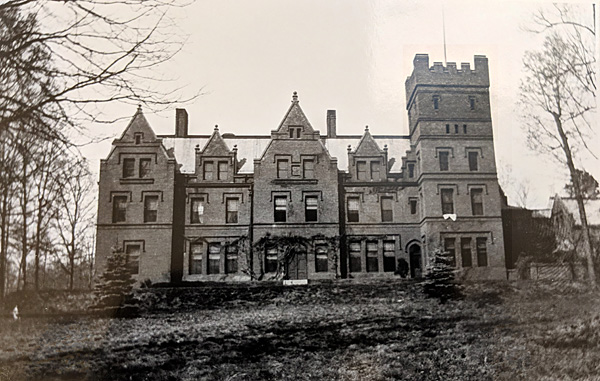

  |
|

|
Name: Nydrie Comments: In the 1890's, Harry Douglas Forsyth purchased the Tom Coles
Farm at Green Mountain in southern Albemarle County, Virginia, and it contained some seven hundred acres of land. Forsyth
was a British-born financier and sugar baron who had moved from New Orleans to southern Albemarle with his wife, Sarah Rice Johnson
Forsyth. By 1898, the Forsyths commissioned the building of Nydrie, a massive manor house modeled after a Scottish baronial
house on Loch Nydrie in Scotland. Nydrie contained fifty rooms, not including hallways and the basement. Nydrie's main entrance hall measured 22
feet by 61 feet, with a height of 28 feet. Will Make A Grand Estate: What Mr. Forsyth is Doing On The Southside: We have several times referred to the splendid residence which is being erected by Mr. Forsyth of New Orleans in the southern part of the country. It is worthy of remark for itself, as being a princely establishment, and also because it has proven a bonanza to that section in furnishing employment to hundreds of workmen, and a consequent means of promoting the interests of everybody in that section. Some time ago, Mr. Forsyth purchased the old Tom Coles farm, at Green Mountain, which contains some seven hundred acres of fine land. Mr. Forsyth is a sugar grower, manufacturer, and heavy dealer in sugar, who has made millions in the business. With a view of highly improving the property above referred to, he last year built thereon several good dwellings for employees and a large and costly barn and stable of brick with slate roof; also an immense dam forming a lake of splendid pure spring water. This year, he is erecting the most splendid private residence known in the Piedmont section of Virginia. It is built of brick, with brown stone trimmings, and slate roof. The main dwelling is 68x175 feet, and three stories high, with a good basement. The main entrance hall is 22x61 feet and 28 feet pitch, which will be furnished elaborately and highly ornamented. It will be used as a ball-room, and just above the front entrance, even with the second floor, is a music gallery. The building contains fifty rooms, besides the basement rooms and large halls, including dining room (16x28 feet), six storerooms, two pantries, bathrooms, a billiard room (21x24 feet), a drawing room (20x24 feet), and a library. The basement rooms will have floors of cement, and the main hall of tiling. Two large tanks will be placed in the two towers for water supply. Several elegant and commodious outbuildings will be erected on the rear premises. All of the rear premises will be enclosed by a high brick wall, in which will be placed elegant iron gates for egress and ingress. The library is to be finished in walnut, the billiard room in ash, and the halls and stair case in quartered oak. The brick and terra cotta work is being done by Messrs. Graham & Holland of Lynchburg, and the woodwork by Capt. J.T. McLaughlin of Lynchburg, sub-contractors under Pettyjohn & Co., of Lynchburg, the original contractors. The building will cost $60,000 or more. An immense water ram has been constructed just below the dam, supplying the entire premises with an abundance of pure fresh water, delivering it through a 3-inch pipe 2,700 feet in length, supplying also the stables and farm pens. At present the building is surrounded by a large oak forest, which will be converted into a park, with flower gardens, walks, drives, etc., and surrounded with an ornamental fence and gateways, that will excel anything ever seen in this section of the country. It is said that the main gate alone will cost about $7,000. It has been a blessing to the vicinity immediately surrounding the place to have these improvements made, as they have furnished wages to many families that needed it. It is thought that Mr. Forsyth will spend about $60,000 outside of the residence, making a total cost of about $120,000. Scottsville Museum wishes to thank Maxwell Johnson for his research and photographs on this Esmont
community home! Copyright © 2018 by Scottsville Museum |
|
|
|
Museum
Archive
Business
Cemeteries
Church
Events
Floods
For Kids
Homes
Portraits
Postcards
School
Transportation
Civil War WWII Esmont Search Policy
|
||||
| Scottsville Museum · 290 Main Street · Scottsville, Virginia 24590 · 434-286-2247 | ||||
|
www.avenue.org/smuseum · info@scottsvillemuseum.com Copyright © 2018 by Scottsville Museum |
||||